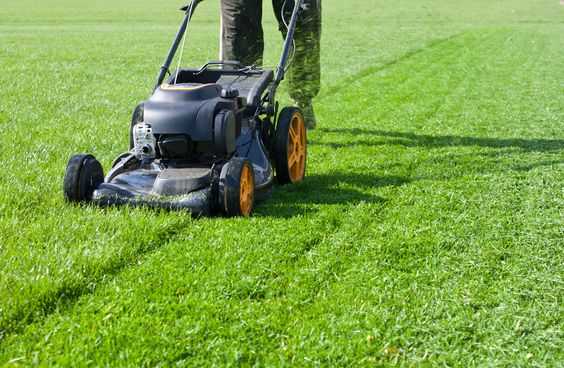How to Tune Up a Lawn Mower
If you love your lawn, there’s perhaps nothing more exciting than giving it a fresh cut on that first beautiful spring day. You pull out the mower, give the cord a yank, and nothing happens. Sitting around all winter has caused your lawn mower not to start, and the local repair shop says it will be next month before they can get it back into action.
Don’t let this happen to you. Take a few extra steps when putting away your mower for winter, and starting it up in the spring will be a snap. Here’s how.
DIY Lawn Mower Tune-Up

Your lawn mower manual comes with instructions for maintenance, so be sure to use it as your guide for specifics about your mower. Set aside a few hours to do the tune-up. You’ll need your toolbox, gloves, and any mower parts you plan on replacing.
1. Stabilize the Power Source. You don’t want your lawn mower sitting around with fresh gas in it, or the battery, either, if you have an electric mower. If there are still any mowing days left in your schedule, try to use up all of the gas while you’re out there on the lawn and then let the tank sit empty. If not, no problem. Just add a fuel stabilizer to the gas tank and run the motor for 5 minutes, so it can circulate through the system. This liquid solution will keep the gas from becoming stale for up to a year (depending on the brand), and help reduce the chance of corrosion.
If you own an electric lawn mower, remove the battery and charge it fully to avoid sulfation (a buildup of crystals that will keep it from charging in the future). Store the battery in a cool, dry place. You don’t want it to freeze, but temps above 75°F are equally detrimental, so find a spot with a steady range in the middle.
2. Disconnect the Spark Plug. Now that you’ve dealt with the fuel, before doing any other work on your lawn mower you need to disconnect the spark plug ignition wire—the wire running to the front of the engine—so there’s no chance of the mower starting accidentally.
3. Change the Oil. The next step is to change the oil. There are 2 ways to drain the oil—the essential first step—but in either case, make sure you dispose of the oil safely. Do not pour any oil into the garbage or down a drain. Most auto service centers will take used oil and recycle it for you, for free or a small fee.

If your lawn mower has a drain plug (typically located under the mower deck), place a pan under the deck and remove the plug with a socket wrench. Let the oil drain into the pan and once it’s run dry, screw the drain plug back in and add fresh oil through the dipstick tube.
If there isn’t a drain plug, you can empty the oil by tilting your mower on the side and draining the dipstick tube. First, to keep any fuel from spilling out, put a plastic bag over the gas tank opening and then screw the cap back on. Then, place a pan on the floor next to the mower, on the side with the dipstick tube. Remove the dipstick and tilt the mower so the oil pours directly into the pan. After it’s all out, add fresh oil, and put the dipstick back in. Leave the plastic on the gas cap for now, until you’re done tilting the mower.
4. Sharpen the blade. A dull blade can rip up your yard, so while you’re tuning up everything else, put on a pair of work gloves and sharpen your lawn mower blade. Tilt the mower on its side, then use a pair of locking pliers and a socket wrench to remove the blade from the mower deck. If the mower blade only has minor wear and tear, secure it in a vice clamp and sharpen it using a metal file. For badly damaged blades, it’s best to take them to a repair shop and have a professional sharpen it for you. Don’t put the blade back on just yet—step 5 should happen first.
5. Clean the mower deck. While the blade is off and the mower is on its side, use a garden hose to spray the underside of the mower deck. This will help loosen any dirt and caked-on grass clippings. For really stubborn dirt or clumps of grass, use a putty knife to pry them loose. Then use a scrub brush and hot, soapy water to finish cleaning the underside of the deck. Rinse, then thoroughly dry it. This is also a great time to touch up any rusted or chipped paint surfaces.
6. Replace the air filter. The air filter is what keeps the engine from overheating after sucking up dirt and debris, so replacing it every season can help extend the life of your lawn mower. Check your owner’s manual to find out what type of air filter your lawn mower has, and where it’s located. Order a new once, swap it out, and consider it done—it’s as easy as that.
7. Replace the spark plug. Most spark plugs need replacing after 50 hours of mowing. With the wire already removed, use a socket wrench to loosen the spark plug itself, then remove it with your hands. Screw on the new spark plug by hand, and take notice of the small gap at the end. Make sure the end isn’t touching the plug itself, as that will prevent a spark and keep the mower from starting. Reconnect the ignition wire and give yourself a pat on the back.
Pro Lawn Mower Tune-Up
Don’t have the time or desire to tune up the mower yourself? Another option for winterizing your lawn mower is to have a professional do it for you. Taking your mower in during the fall or winter can save you from weeks of waiting once the weather is warm!
Lawn Mower Storage
Whether you serviced it yourself or took it in to the pros, you now want to store your lawn mower properly. Find a dry, clean location out of the reach of children, and cover it. Never store it in the house or near an ignition source, like a furnace or water heater.
Now that you’ve taken care of putting your lawn mower away for a long winter’s nap, you can kick back for the season. But if your New Year resolves to have one of the best-looking lawns on the block, use this time to read our tips and tricks for mowing like a pro. Once spring comes, both you and your lawn mower will be ready to get out there and go.



